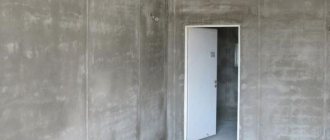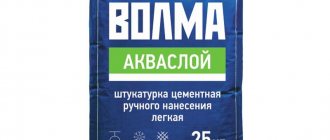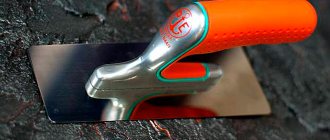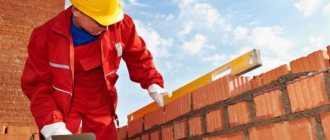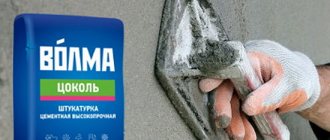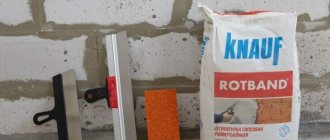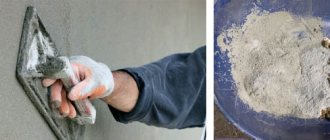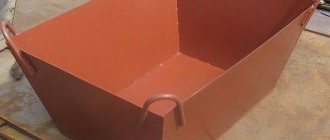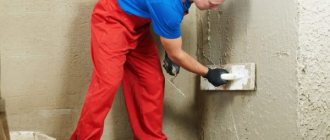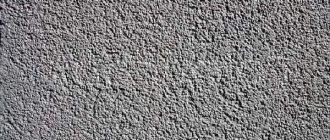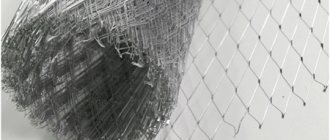Volma Aquaslayer is one of the companies that appeared on the market relatively recently. But the products have already proven themselves only from the best side. Gypsum plaster has become the most common product and is in high demand. It is sold in different packaging, which is especially convenient. Most often used for rooms where there are no differences in temperature and humidity.
Plaster Volma Aquaslayer description
Among the assortment from this manufacturer you can find compounds that help perform any type of work. There are even decorative materials, not to mention finishing, leveling, and plastering materials.
Volma Aqua contains only environmentally friendly products that do not cause any harm to human health. The main share is allocated to substances of mineral origin. But it could not do without binding components and additives, synthetic elements. Some types of plasters can be applied by machine, others only by hand.
Volma Aqua contains only environmentally friendly products that do not cause any harm to human health.
Positive properties
The popularity of the material “Volma. Layer" acquired due to a number of positive qualities. Namely:
- Easy to apply. The plasticizers included in the mixture make its application quite simple, so there is no need to make special efforts during the work process.
- No shrinkage. Unlike similar products for leveling walls, Volma plaster can be applied in one large layer (up to 6 cm).
- Environmental friendliness. The manufacturing company does not use harmful components to manufacture its products, as stated on the packaging of the material.
- No need to putty the walls. Plaster "Volma. Layer" can be applied directly to the walls, without preliminary treatments. After the solution has dried, the surface also does not need to be covered with a layer of finishing putty, since the plaster has an attractive glossy appearance.
- Excellent vapor permeability. Mixtures of this, which have a beneficial effect on the internal microclimate of the room.
Specifications
You can choose a composition for any application. Including for rooms with varying degrees of humidity. You just need to study in advance the technical characteristics that distinguish this or that composition, including lightness.
You can choose a composition for any application.
Compound
The cement or gypsum base for these plasters is the most common. Plasticizers, stabilizers and modifiers are introduced to improve certain qualities. An example is stickiness, strength, and so on.
The cement or gypsum base for these plasters is the most common.
Colors
The characteristic shades for these mixtures are light yellow, beige and gray. Scope of application: leveling various surfaces. White color is most often used when selling finishing materials. It is permissible to use colors in relation to plasters, but such solutions are only suitable for decoration. After drying, the surface is easier to treat with paints, regardless of the composition.
After drying, the surface is easier to treat with paints, regardless of the composition.
Layer thickness
5-30 mm is the recommended thickness in most processing situations. 6 centimeters is the permissible thickness for the plaster layer, but in this case, preliminary reinforcement is required. In the absence of restrictions, the established minimum is 3 millimeters.
5-30 mm is the recommended thickness in most processing situations.
Adhesion (stickiness), strength
A high degree of adhesion in relation to various building materials is characteristic of any compositions from this manufacturer. The compressive strength will be 3.5 MPa. Bending strength – 1.5 MPa.
A high degree of adhesion in relation to various building materials is characteristic of any compositions from this manufacturer.
Frost resistance, moisture absorption
Some plasters can withstand up to 75-100 cycles of defrosting and freezing, which is achieved by the presence of special additives in the composition. Most materials will withstand temperature drops down to -40 degrees without problems. A low degree of water absorption is also relevant in all cases.
Most materials will withstand temperature drops down to -40 degrees without problems.
Consumption per 1 m2 of wall
As with other SS, the consumption for the mixture per 1 m2 is indicated for a layer whose thickness is 10 mm. The figure given on the packaging is 8-9 kg - average. So, to cover a flat area of 1 square meter with a solution thickness of 3 cm (30 mm) you will need 24-27 kg (based on the calculation of 8kg * 3cm or 9kg * 3cm).
In fact, plastered walls, partitions or ceilings are far from even. Filling and leveling large depressions, cracks, and joints may require more mixture. More test is also required for curved, for example, columns, as well as other curved surfaces. You can also use our online calculator to calculate.
Preparations for work
Optimal environmental conditions are the first condition that needs to be taken care of. Temperatures are expected to range from 5 to 30 degrees above zero. Humidity – up to a maximum of 80%. If these conditions are rejected, the layer will simply collapse and fall off the surfaces. If the walls are frozen, processing them is prohibited. You need to wait some time until the temperature reaches the required levels, otherwise the plaster composition will not give results.
Optimal environmental conditions are the first condition that needs to be taken care of.
Surface preparation
The wall, ceiling or other area that is being treated requires additional preparation. Dirt and various stains, traces of previous finishing must be completely removed. If necessary, use a solvent to clean everything. Parts made of metal are treated with anti-corrosion agents. Some plaster is also needed here.
It is permissible to take other precautions:
- Cleaning walls from traces of mold and mildew. All surfaces are coated with antiseptic. This work is especially important when indoor humidity levels are constantly high. The putty is applied afterwards;
- Getting rid of traces of salt deposits. Washing large depressions with cement mixtures. The cracks need to be widened, and be sure to coat them;
- Applying primer in 1-2 layers. It is better to use a primer from the same company whose compositions are used at the very beginning.
It is better to use a primer from the same company whose compositions are used at the very beginning.
Where and what is it used for?
According to the manufacturer of SS Volma Layer, the technical characteristics allow the material to be used for manual plastering of bases made of materials such as:
- concrete walls;
- gypsum fiber boards (GVL);
- drywall;
- plasters with cement-lime binders;
- aerated concrete;
- gypsum slabs and blocks;
- brick;
- foam concrete.
The mixture is used to level ceilings, partitions and walls under conditions of normal or dry humidity in the room. It is used if the planned finishing is painting, tiles, wallpaper or decorative plaster.
The reader got acquainted with the Russian-made gypsum composition - Volma layer. Technical characteristics will help not only when choosing, but also when making calculations, for example, how much CC should be purchased. The information will also help you properly manage the material (temperature conditions, setting time, how long the raw material can be stored).
Technology of working with Volma-layer plaster
Experts recommend applying a so-called test layer at the very beginning. Then it will be easier to understand how long it takes for the composition to set. Labor costs and expenses are also determined separately. At this stage, the thickness of the required layer is established, so that later it will be easier. It may differ slightly from analogues.
Experts recommend applying a so-called test layer at the very beginning.
Preparation of the solution
The container is filled with clean water, the standard calculation is 1 kilogram of mixture per 0.28-0.3 liters of water. Then add the dry plaster mixture in the required quantity. The solution is mixed with professional construction mixers, at an average speed of up to 600-800 rpm. You should get a homogeneous plastic mass that has no lumps. For maturation, a technological pause of 3-5 minutes is maintained, then they begin to re-mix so that the cement mortar becomes more effective.
The viability of the mixture is 2 hours if the surrounding temperature reaches 25 degrees. The time can be increased or decreased by lowering or raising the temperature itself. The technical indicator is adjusted without problems.
You should get a homogeneous plastic mass that has no lumps.
Working methods
If all operations are performed correctly, the result will be a smooth surface that meets all requirements. Finishing work can begin just three hours after application.
The plastering work itself involves the following sequence of actions:
- The prepared solution is applied to the surface using a trowel.
- They level with another tool called a “rule”.
- The second layer is applied after the first has completely dried. 40-60 minutes is the standard setting time.
- After 20-30 minutes, the surface is generously moistened with water using a sponge.
- A spatula is used for leveling. How long the material will dry is determined by the operating conditions.
If all operations are performed correctly, the result will be a smooth surface that meets all requirements.
How to prepare a solution.
Proportions: 1 kg of mixture is diluted in 0.5 liters of water. It is recommended to mix the solution in plastic containers, which must be clean and dry.
For mixing, it is best to use professional tools, for example, a construction mixer or a drill with a special attachment. As a result, Volma “Plast” gypsum plaster should acquire a homogeneous mass.
Important: the mixture must be dissolved in clean water, which should be at room temperature.
The resulting consistency can be adjusted by adding water or a mixture. The resulting solution should be allowed to sit for several minutes, after which it should be carefully applied to the base with special tools.
Volma “Plast” is a gypsum plaster, the characteristics of which allow it to be used not only for treating the base, but also as a final decorative element.
Advantages
A large number of reviews, both positive and negative, are published about the products of this company. But there are more positive aspects compared to the disadvantages.
The following list can be used as evidence:
- Regulation of the indoor microclimate due to the fact that the surface is breathable;
- The result is a smooth, glossy surface that does not require preliminary puttying;
- Easy to use, even if a light finish is used;
- Reasonable price combined with excellent quality;
- Moisture resistance;
- Low consumption;
- Environmental friendliness;
- High stickiness;
- Frost resistance.
You can create textured surfaces if no further finishing work is carried out.
Regulation of the indoor microclimate due to the fact that the surface is breathable.
Scope of application
This composition is used for both small and global work. The scope of application of the material is limited only by the fact that its main component absorbs moisture very strongly, so it is not recommended to use the composition outdoors and in damp rooms.
Most often, gypsum plaster “Volma. Layer" is used for the following work:
- during restoration and removal of small surface defects;
- in minor repairs for leveling walls and ceilings;
- during primary and major leveling of surfaces;
- as a finishing coating for walls;
- for creating various decorative interior elements (arches, stucco moldings, sculptures, etc.).
Flaws
Users note that sometimes there are mixtures with large fractions. This has a negative effect on subsequent wallpapering. Preliminary priming and heterogeneous mass are also disadvantages. But if necessary, they are easy to handle; for this purpose, a manual application method is used.
Users note that sometimes there are mixtures with large fractions.
An acceptable cost is typical for all formulations produced by this company. 1 kilogram of gypsum mixture, for example, will cost up to 10-15 rubles. 290 rubles is the average cost of one bag weighing up to 30 kilograms. The required amount is easy to calculate in advance, focusing on the approximate consumption. Then the total costs of repairs can be calculated without any problems.
Assortment of dry mixtures for floor leveling
If you look at the “labor path” of the vast majority of domestic companies in this field of construction materials production, you will notice a general pattern. Most often, they were founded in the 90s or 2000s, after which their rapid growth followed, coinciding with a sharp increase in the volume of private construction in Russia. As a rule, the very idea of organizing such production was prompted by the successful activities of foreign companies, and, in fact, was aimed at creating competition in this segment of the construction market, relying on local resources and counting on accessibility for domestic consumers.
Volma is a company with extensive experience and a very extraordinary history.
Against this general background, it stands out very much with its extraordinary history. It is very noteworthy that the decision to create a plant for the production of building materials was made literally immediately after the end of the Battle of Stalingrad. The city was completely destroyed, and a colossal amount of materials was required to restore it as quickly as possible. Therefore, the construction of the first production facilities began in 1943, and already in January 1949, the Stalingrad Gypsum Plant began shipping finished products, constantly increasing its range and volumes.
It is interesting that the same plasterboard, which in our time is one of the most modern and popular construction and finishing materials, was put into production at the plant back in 1953, under the name “dry plaster”.
Nowadays, production capacity is not limited to Volgograd. Plants were launched in the Moscow, Orenburg and Chelyabinsk regions, and in the Republics of Tatarstan and Adygea. This is understandable, since the demand for the products of this brand is traditionally high.
Prices for self-leveling floor "Volma"
self-leveling floor "Volma"
Powerful production complex "Volma-Maikop" in the Republic of Adygea
The modern range of products produced under this brand is very wide. These are plaster and putty mixtures, assembly and tile adhesives, plasterboard of various modifications, tongue-and-groove gypsum boards, thermal insulation mats, special solutions and primers. A separate “section” in this list includes mixtures for leveling floors. To date, five titles have been presented:
- "Volma the Rough Riveter"
- "Volma Level Arena"
- "Volma Level Express"
- "Volma Leveling Top"
- "Volma Level Comfort"
The compositions differ in their characteristics and purpose. Therefore, it makes sense to consider each briefly separately.
"Volma the Rough Riveter"
To be honest, such a composition cannot justifiably be attributed specifically to self-leveling floors. Rather, in terms of its working consistency and installation principle, it is closer to the “classic” screed. Nevertheless, we will pay attention to it, especially since “Volma Rough” is very often used in “tandem” with other liquid formulations of this brand.
"Volma Leveler Rough" - allows you to eliminate very strong level differences and surface unevenness
The composition is made on a cement base, with the addition of lime to increase the plasticity of the composition. Filler – purified fractionated sand. In addition, to increase the strength of the resulting screed, fiber fibers are included in the mixture, creating internal reinforcement. High adhesion, ductility, non-shrinkage, rapid hardening and strength gain are ensured by a complex of polymer additives.
The composition is suitable for both interior work, without restrictions on the degree of humidity of the room, and for exterior work. It fits perfectly into any “warm floor” system, both as a rough foundation and as a heat-accumulating screed covering the laid contours of pipes or cables.
It has very respectable frost resistance - F50.
After hardening, Volma Rovnitel Rough can be easily sanded or can become the basis for subsequent pouring of a thin-layer self-leveling compound. However, if the requirements for ideal surface smoothness are not strictly set, then with effort you can achieve a flat floor with such a composition, so to speak, in one go.
The fluidity of the diluted mortar is low, so it is usually laid manually and leveled according to the beacon system, like a regular screed.
The main parameters of the composition are in the table below:
| Name of characteristics | Indicators |
| Application layer: | |
| - acceptable | Up to 100 mm |
| - optimal | From 10 to 80 mm |
| Mixture consumption for a layer of 10 mm | 18÷20 kg/m² |
| Standardized amount of water for mixing the solution: | |
| - per 1 kg of mixture | 0.13÷0.15 l- |
| — per package (25 kg) | 3.25÷3.75 l |
| Mixing water temperature | + 10÷30 °C |
| Temperature of the base for pouring | + 5÷30 °C |
| Viability of the solution after mixing | At least 120 min. |
| Possibility of walking after filling: | |
| - under normal conditions | In 7 hours |
| — at temperatures from +5 to +10 °C | In 12 hours |
| Strength after full ripening: | |
| - for compression | Not less than 20 MPa |
| - detached from the base | Not less than 0.3 MPa |
| Frost resistance | At least 50 cycles |
| Possibility of further work: | |
| — final leveling or laying of ceramic tiles | After 7÷14 days |
| — laying laminate, parquet boards, linoleum, etc. | After 21÷28 days |
| Factory packaging | Kraft bag net 25 kg |
| Approximate price per package | From 180 rub. |
"Volma Level Arena"
This composition also has a cement base, and is also intended for thick-layer leveling of floors with significant defects. True, already in the name itself the manufacturer directly refers it to liquid formulations.
Prices for Volma Level Arena
"Volma Level Arena"
"Volma Leveling Arena" - self-leveling composition for thick-layer leveling of floors
After complete hardening, a very durable base is created that is not afraid of high loads, high humidity and temperature changes. "Volma Level Arena" is equally good for both external and internal work. For example, it will be an excellent wear-resistant floor in a garage, especially if it is then coated with a special paint for concrete.
How can you paint a concrete floor?
Painting may well be a very successful alternative to tiles or other concrete floor coverings. Such finishing not only removes dust from the surface - it waterproofs it, gives it additional strength qualities, and transforms it aesthetically. What paints exist for concrete floors and how they are used - read in a special publication on our portal.
The composition is intended exclusively for manual application. It is quite suitable for “warm floor” systems. The minimum boundary of the filling layer is only 5 mm, which allows, if necessary, to immediately perform the final leveling of a heavily rough base, without resorting to thin-layer “levels”.
The composition characteristics are given in the table:
| Name of characteristics | Indicators |
| Application layer: | From 5 to 100 mm |
| Mixture consumption for a layer of 10 mm | 15÷16 kg/m² |
| Standardized amount of water for mixing the solution: | |
| - per 1 kg of mixture | 0.2÷0.23 l- |
| — per package (25 kg) | 5.0÷5.75 l |
| Mixing water temperature | + 5÷30 °C |
| Temperature of the base for pouring | + 5÷30 °C |
| Viability of the solution after mixing | No more than 60 min. |
| Possibility of walking after filling: | In 24 hours |
| Strength after full ripening: | |
| - for compression | Not less than 20 MPa |
| - detached from the base | Not less than 0.6 MPa |
| Frost resistance | At least 50 cycles |
| Operating temperature range | 0t – 40 to + 70 °C |
| Full strength set | After 28 days |
| Possibility of further work: | |
| - laying ceramic tiles | In 7 days |
| - laying linoleum or textile coverings | After 7÷10 days |
| — laying laminate, parquet boards, linoleum, etc. | After 10÷14 days |
| Factory packaging | Kraft bag net 25 kg |
| Approximate price per package | From 320 rub. |
"Volma Level Express"
This bulk composition is intended for interior work, only in heated rooms. There are also restrictions on the degree of humidity - such a screed is not intended for bathrooms, baths, showers.
Prices for Volma Level Express
"Volma Level Express"
"Volma Level Express" - for rough and fine leveling of floors in any premises, except those operated in high humidity conditions
The composition has a complex gypsum base - with fine-grained sand filling and polymer plasticizer additives. This determines the low consumption of the mixture per unit area, the good fluidity of the solution, and its rapid hardening after pouring and distribution.
The composition can also be used in the “warm floor” system. Moreover, if it itself becomes a heat-accumulating screed covering the contours, its thickness should be at least 40 mm. Well, if “Volma Level Express” serves only as a finishing leveling coating over a “warm floor”, then you can limit yourself to a thickness of only 5 mm.
Among all the self-leveling floors of the Volma brand, it is Nivelir Express that, perhaps, remains the most popular among private developers and professional finishers. This is largely due to the very favorable price of the dry mixture.
The main characteristics of the composition are summarized in the table:
| Name of characteristics | Indicators |
| Application layer: | From 5 to 100 mm |
| Mixture consumption for a layer of 10 mm | 12.5 kg/m² |
| Standardized amount of water for mixing the solution: | |
| - per 1 kg of mixture | 0.29÷0.34 l- |
| — per package (20 kg) | 5.8÷6.8 l |
| Mixing water temperature | + 5÷30 °C |
| Temperature of the base for pouring | + 5÷30 °C |
| Viability of the solution after mixing | No more than 60 min. |
| Possibility of walking after filling: | After 4÷6 hours |
| Strength after full ripening: | |
| - for compression | Not less than 15 MPa |
| - detached from the base | Not less than 1.0 MPa |
| Frost resistance | No, only for heated rooms |
| Possibility to load the floor | In 3 days |
| Possibility of laying the finishing coating | With residual humidity no more than 1% |
| Factory packaging | Kraft bag net 20 kg |
| Approximate price per package | From 240 rub. |
"Volma Leveling Top"
A very convenient composition when high-quality thin-layer leveling of the surface is required for further finishing. The peculiarity lies in the possibility of pouring a layer of only 3 to 20 mm thick in rooms and areas where difficult operating conditions are expected: high load, temperature changes, high humidity, etc.
"Volma Leveling Top" - ideal thin-layer floor leveling for the most unfavorable conditions of future operation
As you can immediately understand, this composition is equally suitable for any interior space and for exterior work. For example, with its help you can achieve ideal leveling of areas on the porch, terrace, veranda, gazebo or balcony. The coating is not afraid of frost and high humidity, and the permissible operating temperature ranges within impressive limits - from -40 to +70 degrees. This is quite suitable for the vast majority of regions of Russia.
Prices for "Volma Level Top"
"Volma Leveling Top"
The composition is based on special modified cement, enriched with plasticizing and strengthening additives. There are no restrictions on the use of Volma Level Top in any underfloor heating systems.
The main characteristics of the composition can be found in the table:
| Name of characteristics | Indicators |
| Application layer: | From 3 to 20 mm |
| Mixture consumption for a layer of 10 mm | 16 kg/m² |
| Standardized amount of water for mixing the solution: | |
| - per 1 kg of mixture | 0.21÷0.24 l- |
| — per package (20 kg) | 5.25÷6.0 l |
| Mixing water temperature | + 5÷30 °C |
| Temperature of the base for pouring | + 5÷30 °C |
| Viability of the solution after mixing | From 40 to 60 min. |
| Possibility of walking after filling: | After 4÷6 hours |
| Strength after full ripening: | |
| - for compression | Not less than 20 MPa |
| - detached from the base | Not less than 0.75 MPa |
| Frost resistance | At least 50 cycles |
| Operating temperature range | From – 40 to + 70 °C |
| Period of complete drying and strength gain | 28 days |
| Factory packaging | Kraft bag net 25 kg |
| Approximate price per package | From 430 rub. |
"Volma Level Comfort"
Composition on a complex basis (with a predominance of the gypsum component), allowing for ultra-fine leveling. According to assurances, it can be applied, as they say, “to scratch,” that is, in a layer, starting literally from scratch. A very important property when it is necessary to perfectly level the floor in conditions of severely limited coverage in height.
"Volma Leveling Comfort" is suitable for super-thin finishing floor leveling
This self-leveling floor is intended exclusively for interior use, for rooms with normal humidity levels. The mixture is completely environmentally friendly, completely harmless even for people with a predisposition to allergies, and is recommended for renovation in the premises of medical and educational institutions. High-quality gypsum helps maintain the most comfortable microclimate.
At the same time, the strength indicators of the frozen layer are quite decent. "Volma Level Comfort" will fully withstand operation as part of a floor heating system.
The characteristics of the Volma Nivelir Comfort self-leveling floor are shown in the table:
| Name of characteristics | Indicators |
| Application layer: | |
| - acceptable | From 0 to 100 mm |
| - optimal | From 5 to 80 mm |
| Mixture consumption for a layer of 10 mm | 12 kg/m² |
| Standardized amount of water for mixing the solution: | |
| - per 1 kg of mixture | 0.29÷0.34 l- |
| — per package (20 kg) | 5.8÷6.8 l |
| Mixing water temperature | + 10÷30 °C |
| Temperature of the base for pouring | + 5÷30 °C |
| Viability of the solution after mixing | No more than 60 min. |
| Possibility of walking after filling: | In 4 hours |
| Possibility to load the floor | In 3 days |
| Strength after full ripening: | |
| - for compression | Not less than 15 MPa |
| - detached from the base | Not less than 1.0 MPa |
| Frost resistance | No, only for heated rooms |
| Possibility of subsequent work | With residual humidity no more than 1% |
| Factory packaging | Kraft bag net 20 kg |
| Approximate price per package | From 250 rub. |
And also get acquainted with the varieties and technology of pouring self-leveling floors with a pattern in a special article on our portal.
Prices for "Volma Level Comfort"
"Volma Level Comfort"
Important Tips
- When purchasing material, you should take a little more of it than required. In this case, you can quickly dilute the mixture further.
- The working time with the finished mixture indicated on the packaging ranges from 45 minutes to 1 hour, but it is advisable to use up all the material in 20-30 minutes.
- As a rule, on the packaging you can read important information about the mixture consumption per 1 square meter. meter. However, these calculations are only approximate, since the consumption will depend on the curvature of the walls, the presence of seams, and so on.
- To prepare plaster mixtures, use only clean plastic containers. It is not necessary to buy a new bucket for these purposes. You can use available materials, for example, a large plastic bottle with the top cut off.
